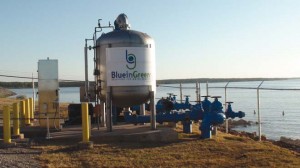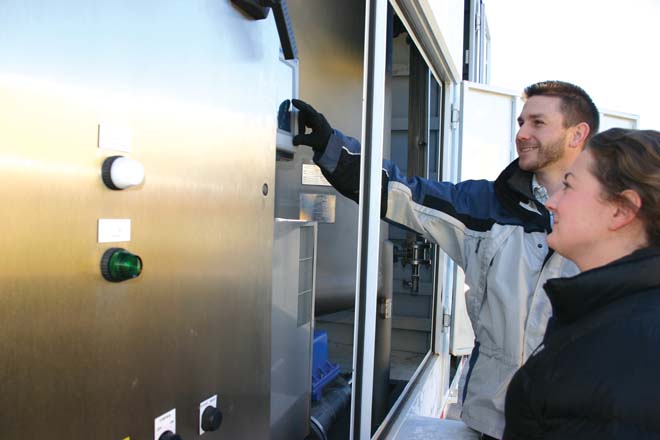Behind the Arkansas Research and Technology park lies a peaceful-looking pond surrounded by reeds. But this retention pond is more than just an incongruous piece of nature in a high-tech setting. It’s an outdoor lab, a place for BlueInGreen, LLC, a Virtual Incubation portfolio company founded by U of A engineering professors Marty Matlock and Scott Osborn, to test and refine its watertreatment technology.
A few feet from the shore, a miniature version of the company’s patented SDOX machine is being used to study processes to keep the pond healthy. The unit, which is owned by the U of A Technology and Development Foundation, draws small amounts of pond water into a tank, where it saturates the water with oxygen before pumping it back. This process is an efficient and costeffective way to put oxygen into water, and BlueInGreen’s unique technology has earned it national recognition.
The Need for Oxygen

BlueInGreen, in partnership with the Oklahoma Water Resources Board and the Central Oklahoma Master Conservancy District, installed an SDOX system on Lake Thunderbird in Oklahoma, which serves as both a drinking water source and a recreational destination for residents in the Oklahoma City metropolitan area. The lake has suffered from low dissolved oxygen levels because of an increase of nutrients flowing into the lake over the past several years.
In wastewater treatment, oxygen is a vital ingredient, because it supports the bacteria that break down waste products. The more oxygen available in the water, the more efficiently the bacteria function. “The cheapest way to get rid of some of the bad stuff in the water is bacteria,” explained Osborn. “Adding more oxygen increases treatment capacity without increasing the footprint of the facility.” Oxygen also keeps the bacteria from smelling bad, because when bacteria run out of oxygen, they switch to anaerobic processes, which produce unpleasant odors.A New ApproachTraditional methods of dissolving oxygen in water are not very efficient. In most wastewater treatment facilities, large amounts of water are pumped full of bubbles, mixed with air in a surface agitator or flowed over a drop structure to produce turbulence. These methods can result in wasted oxygen, as the gas escapes across the surface of the water or bubbles back into the air.
The SDOX machine takes a different approach, spraying particles of water into oxygen gas. The result is water that contains up to 350 milligrams of oxygen per liter. In Arkansas streams, the required level of oxygen can be up to 10 milligrams per liter, which means a little bit of SDOX-treated water goes a long way.
The company’s technology is currently in use at the Noland Wastewater Treatment Facility in Fayetteville and Lake Thunderbird in Oklahoma. An SDOX machine helped clean up a creek that was contaminated by sewage during Hurricane Sandy, and the company is studying the use of its technology in salt water, with the aim of cleaning up oil spills and restoring dead zones in the Gulf of Mexico. In 2010, the company received the Innovative Technology Award from the Water Environment Federation.
Creating Jobs

Darryl Fendley and Jessica Hart, two U of A graduates who are applying their skills as BlueInGreen employees.
Several of BlueInGreen’s employees are U of A students or graduates, including Darryl Fendley, who earned a master’s degree in environmental engineering from the U of A, and Jessica Hart, who has a bachelor’s degree in biological engineering, and got involved with the company while working with Osborn as an undergraduate. Fendley enjoys being on the cutting edge of water quality. “We’re pioneering a new way to do something,” he explained. “There’s not a lot of other people trying to do this kind of thing.”
Into the Future
Clete Brewer, president and CEO, sees BlueInGreen as a company that provides a “total package solution,” to its clients, offering expertise and project management along with equipment. Brewer explained that the company is ready for the next phase of business success. “We’re over the curve of the ‘prove it’ mentality,” he explained. “The future is going toe to toe and winning.”


